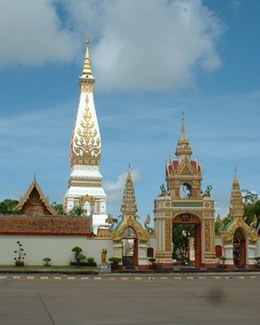Wat Phra That Phanom
| Wat Phra That Phanom | |
|---|---|
วัดพระธาตุพนม | |
 Main Pagoda | |
| Religion | |
| Affiliation | Theravada Buddhism |
| Location | |
| Location | That Phanom District, Nakhon Phanom Province, Thailand |
Wat Phra That Phanom (Thai: วัดพระธาตุพนม) is a Buddhist temple in the That Phanom District in the south of Nakhon Phanom Province, all within the Isan region of Thailand near the Lao border. According to local legend, the temple contains in the pagoda the Phra Uranghathat (พระอุรังคธาตุ)/Phra Ura (พระอุระ)/Buddha's breast bones. As such, it is one of the most important structures for Theravada Buddhists and the most important Buddhist site in the province, with an annual week-long festival being held in the town of That Phanom to honour the temple. These festival attract thousands of people who make pilgrimages to the shrine.[1] In Thai folk Buddhism, Wat Phra That Phanom is a popular pilgrimage destination for those born in the year of the Monkey.
The temple contains a number of paintings illustrating traditional Thai proverbs.
History
[edit]
The That Phanom Chronicle documented that the Phra That Phanom stupa was first constructed 8 years after the Buddha's passing by the five kings of the Mon kingdom, known as Sri Gotupura.[2][3][4]: 6, 7 [5][6] However, archaeological findings suggest that the earliest structure found dates back to the 7th or 8th century CE.[7]
According to local legend, the Buddha told Mahakasyapa, one of his principal disciples, that once he died, Mahakasyapa was to bring his breast bones to 'Phu Kampra to allow Buddhism to continue on. Then in 525 B.C, Mahakasyapa then decided on constructing a temple on Phu Kampra. Joined by 500 Arhats and 5 Phrayas, they built the Phra That Phanom stupa primarily from clay and once completed, the Buddha's breastbones were brought over from India and placed inside.[1]
The pagoda is believed to have been built before the 1100s with its original Khmer design. However years of being part Lao kingdoms led to several renovations which created the current pagoda in a Lao style.[1] In 1690, the pagoda was restored and raised to about 47 meters, and then by a further 10 meters in 1940.[8][9][1]
In 1935, the complex was registered as an ancient monument for preservation by the Fine Arts Department of Thailand.[10]
In March 1975, an earthquake caused cracks to appear. On 11 August 1975 at 7:38 p.m, the entire pagoda collapsed due to several days of heavy rain. it was rebuilt with funds raised by public subscription and from the Royal Thai Government, which was completed on 23 March 1979.[11][12][13] Then current king Bhumibol and Queen Sirikit along with other royal members visited the site when the Buddha's relics were re-installed. Many valuables were placed inside during its rebuilding and a 110 kilogram gold sphere was added on top the pagoda. Buddhists from Laos also participated, placing many valuable items from Vientiane within, such as Lan Xang style golden seven-tiered umbrella.[1] To help protect the temple,

around 4 hectares around the front part were included into the register to further help preserve the site. This is called the 'Buddha Area'.[10]
Architecture
[edit]The 53-meters tall square pagoda was originally made in a Khmer style when it was first created before the 12th century. However renovations when it was under Lao control led to it having its current Lao pagoda design. The stupa's unique architectural style combines Dvaravati, Khmer, and Cham art.[14] The architectural style of the temple inspired other temple designs in the area.[10]
See also
[edit]- Phra Pathom Chedi
- Phra Mahathat Kaen Nakhon
- Phra That Kham Kaen
- Wat Pa Thama Uthayan
- Wat Thung Setthi
- Wat Photharam, Maha Sarakham
- Phra That Choeng Chum
References
[edit]- ^ a b c d e "Phra That Phanom". www.tourismthailand.org. Retrieved 23 May 2023.
- ^ Pruess, James (1976). The That Phanom Chronicle: A Shrine History and Its Interpretation. Ithaca, New York: Cornell University.
- ^ Martin Stuart-Fox (6 February 2008), Historical Dictionary of Laos, p. 328, ISBN 9780810864115, retrieved 26 February 2021
- ^ Phra Thep Rattanamoli (1976). "The That Phanom chronicle : a shrine history and its interpretation". Retrieved 27 February 2021.
- ^ Kislenko, Arne (2009), Culture and Customs of Laos, p. 19, ISBN 9780313339776, retrieved 26 February 2021
- ^ "The Mon and Khmer Kingdoms". Retrieved 26 February 2021.
- ^ "Tentative Lists Phra That Phanom, its related historic buildings and associated landscape". UNESCO World Heritage Centre. Retrieved 3 May 2023.
- ^ "Wat Phra That Phanom". Retrieved 26 February 2021.
- ^ Wanweena (29 August 2014). "Wat Phra That Phanom, Sacred Gem of Thailand's Northeast". Retrieved 26 February 2021.
- ^ a b c Centre, UNESCO World Heritage. "Phra That Phanom, its related historic buildings and associated landscape". UNESCO World Heritage Centre. Retrieved 23 May 2023.
- ^ Hongsuwan, Pathom (27 December 2017). "That Phanom Stupa: Spiritual Space and Invented Traditions in Present-Day Northeastern Thailand". Journal of Mekong Societies. 13 (3): 19–39. Retrieved 26 February 2021.
- ^ "Temples Near Udon Thani - Wat Phrathat Phanom, That Phanom, Nakhon Phanom". Retrieved 26 February 2021.
- ^ "45 ปี พระธาตุพนมล้ม สู่ การรอเป็นมรดกโลก" (in Thai). 21 August 2020. Retrieved 26 February 2021.
- ^ Kesinee SRIWONGSA (12 June 2020). "THE STUDY OF IMPORTANCE OF PRA THAT PHANOM THROUGH ITS REPLICA". Silpakorn University. Retrieved 3 May 2023.
External links
[edit]16°56′36.24″N 104°43′33.59″E / 16.9434000°N 104.7259972°E
